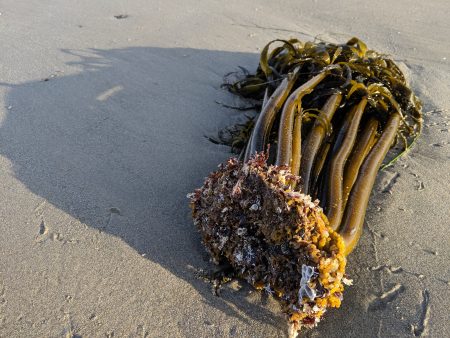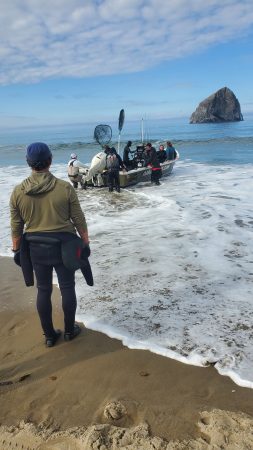
OREGON COAST — This is what it is like to descend into a kelp forest
Underwater, the swaying bull kelp is a color that is hard to describe and light and color bounce off of everything around you. There are bright pinks from coral, purples from algae. Down near the bottom, the kelp’s rootlike holdfast clings tightly to rocks. A stem that can be as long as 60 feet extends upward, ending in a bulb. Waving, gold-brown blades flare out from the bulb and float toward the water’s surface. The water all around is alive with movement and shapes; fish and marine animals of all sorts find habitat and food here.
It is an underwater cathedral, said Sara Hamilton, a diver and post doctoral researcher at UC Davis with expertise in kelp forest ecology.
“When I say an ‘underwater cathedral,’ it does feel almost spiritual,” she said.
But this is in a healthy kelp forest.

In California, such forests have nearly disappeared after unusually warm ocean conditions hit the West Coast in 2014 and persisted for several years after. Since then kelp forests off Northern California have dropped by more than 90 percent, a decline that has led to the shutdown of fisheries and carries major ecological and economical impacts for the state.
Now some in Oregon are saying a number of kelp forests in the state’s waters may be in the early stages of a very similar collapse. But the Oregon Kelp Alliance, a group that includes divers, tribal members, natural resource managers, fishermen, biologists, chefs and others, is trying to get ahead of the problem.
This summer, they began to experiment.
Building a tool kit
In August, alliance members, partner organizations and more than a dozen volunteer divers gathered at Cape Kiwanda near Pacific City. Working in shifts and ferried out by dory boats, the divers dropped into the water, hammers in hand, to smash sea urchins.
Kelp forests play a critical and complex role in the ecosystem. They provide key habitat and shelter prey for a variety of species. They act as a nursery for commercially important species like salmon and rockfish. When kelp washes ashore, it helps fertilize beaches.
The decline of some of Oregon’s kelp forests is a story that has been unfolding for several years and there are many possible factors at play.
There were the sudden shifts in ocean conditions like the marine heatwaves the West Coast experienced beginning in 2014. Certainly, the overall march of climate change plays a role. So also does mysterious sea star wasting disease which led to massive die offs of sea stars in 2013 and 2014, in particular the sunflower sea star, a voracious predator of kelp-chomping urchins. Sunflower sea stars are now considered functionally extinct from Mexico to Washington state.
Without the sunflower sea star to help keep things in check, divers and researchers noticed a surge in purple sea urchin populations. The urchin boom decimated some kelp forests, turning the once teeming, underwater cathedrals into barrens. In some places, a diver could put a hand down and touch five different urchins at once, then look up and see only urchins across the sea floor.
It was a perfect storm of unfavorable and favorable conditions for different residents of the ecosystem.
“So that balanced system — you can almost think of it as being knocked off its balance causing this sort of disruption in the ecosystem that led to the observations that we were seeing as divers,” said Tom Calvanese, coordinator for the Oregon Kelp Alliance and a fisheries scientist and former commercial urchin diver.
This year, the Oregon Kelp Alliance secured a state permit to allow them to cull purple urchins in certain spots and take others for research. In the near future, the alliance is also considering planting kelp seedlings and reintroducing predatory sea stars. The goal is to develop a set of best practices for Oregon — build a tool kit — and, through upcoming surveys and partnerships, further flesh out an understanding of the state’s kelp forests.
While there are many ways groups around the world have successfully addressed kelp forest restoration, the Oregon Kelp Alliance isn’t sure yet what will work best in Oregon. Complicating the response is the fact that the decline is not consistent across the state’s kelp forests. In one location, a healthy kelp stand exists alongside an urchin barren — why? No one knows, yet.
No one solution
Calvanese says smashing urchins cannot be the only or even the best solution for restoring the kelp forests.
The scale of the urchin issue is a lot bigger than can be solved by a few divers with hammers, agreed Scott Groth, with the Oregon Department of Fish and Wildlife’s marine resources program. The permit the state issued allows for the smashing of thousands of sea urchins, around a quarter of a million at each site.
It sounds like a lot, Groth acknowledged, until you consider that at the state’s largest offshore reef in Port Orford surveys have reported something like 350 million urchins.
But nor is the solution to simply open up commercial fishing opportunities on the urchins.
“One of the common solutions that people offer up when we have a perceived overpopulation of some species is, ‘Let’s start a commercial fishery,’” Groth said. “The assumption with that is that there’s a latent group of commercial fishermen waiting to catch whatever you don’t want — and that assumption is incorrect.”
While there is a market for sea urchins harvested off the coast, commercial urchin fishing is among the most dangerous fisheries in the world. For the people who undertake it, that’s their life, Groth said. It takes time and expertise to do it successfully and unlike many other commercial fishermen, urchin fishermen rarely jump around between other fisheries.
Of the total permits the state allows for the fishery, eight aren’t even being used.
Still, Groth, also an experienced diver, believes the results from the kelp alliance’s experiments could be important for future state resource management decisions.
This month, the Center for Biological Diversity petitioned NOAA Fisheries to grant Endangered Species Act protection to bull kelp.
Calvanese feels it is important to remain focused on what can be done now to understand and restore kelp forests.
“To me, it feels like a crisis situation,” he said. “We don’t have a lot of time to wait and see what happens. We’ve already done that and we know what happens.”
At the same time, he said, “We don’t want to mischaracterize it either. We don’t want to give people the message that, ‘Oh, it’s just a catastrophe. There’s no healthy kelp forests left in Oregon.’ … No, we are noticing a problem, we’re going to try to study and understand it better and take action to address it, but we’re also going to make sure we pay attention to where things seem to be doing well and what can we learn from that and how do we preserve that.”
‘One little part’
Among the divers involved in last month’s operation at Cape Kiwanda was Christie Davis, owner of Astoria Scuba and Adventure Sports.
A healthy ocean can only help business, she said. Nobody wants to dive in a desert of sea urchins. But even more, it is an environmental issue for her.
“We care about the oceans and we want them to be healthy,” she said. “If this is one little part that we can do, we’re going to do it.”
Davis plans to remain involved with the kelp alliance and help funnel divers and diving gear to future restoration efforts.
Divers like Calvanese, Groth, Davis and Hamilton have a particular emotional stake in the kelp forests, places they have spent a lot of time exploring. They know what the forests should look like and it is shocking to see the change.
But Hamilton’s underwater cathedral is a sight that few on the Oregon Coast, even fishermen who make a living off the ocean, get to see firsthand. Most people who frequent Oregon’s beaches encounter kelp only after winter storms have tossed it onto the shore in huge, ropey piles.
There are many unknowns and unanswered questions about the forests.
“I feel sometimes when we talk about environmental change or climate change, it feels very heavy and sad,” Hamilton said. There’s a sense that we’re losing something.
And that’s true, she acknowledged. But she also sees it as an opportunity for Oregonians on the coast to reimagine their relationship with nature: How to take care of it and benefit from it, and what to do next.
